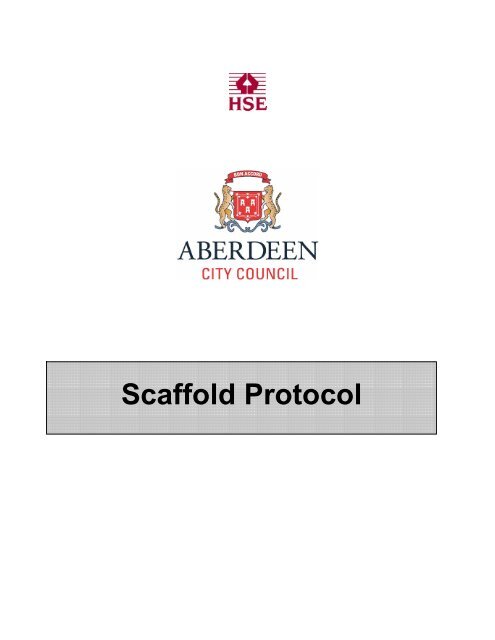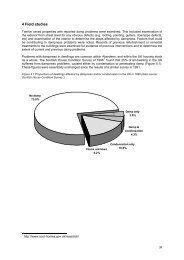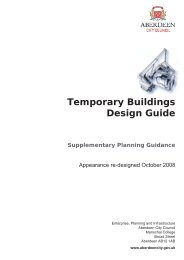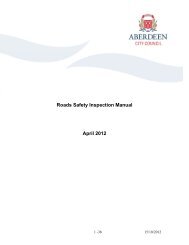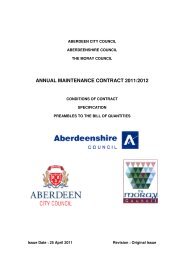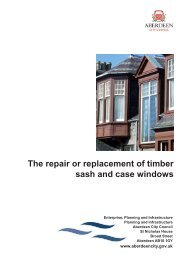Scaffold Protocol - Aberdeen City Council
Scaffold Protocol - Aberdeen City Council
Scaffold Protocol - Aberdeen City Council
- No tags were found...
You also want an ePaper? Increase the reach of your titles
YUMPU automatically turns print PDFs into web optimized ePapers that Google loves.
<strong>Aberdeen</strong> <strong>City</strong> <strong>Council</strong>CONTENTS<strong>Scaffold</strong> protocolSection 1: Mission statement1.1 Mission statementSection 2: Permit Procedures2.1 Road Authority requirements for hoardings and scaffolding2.2 Site meetings and inspections2.3 Traffic management associated with the erection and dismantling of a hoarding andscaffold2.4 Submitting a scaffold permit application2.5 <strong>Scaffold</strong> Application FormSection 3: General <strong>Scaffold</strong> Guidance3.1 Procurement checklist3.2 Hierarchy of protective measures3.3 Competence3.4 Inspection3.5 Security Procedures3.6 Physical Protection3.7 Raising and Lowering Materials3.8 Lighting for <strong>Scaffold</strong>s and Hoarding3.9 Electrical Hazards3.10 Guidance on <strong>Scaffold</strong>ing Works and AsbestosSection 4: <strong>Scaffold</strong> Design and Detail4.1 <strong>Scaffold</strong> Plan4.2 Information to be displayed4.3 <strong>Scaffold</strong> Design4.4 Stability, Bracing and TestingSection 4: AppendicesAppendix 1 Powers and DutiesAppendix 2 Emergency ProceduresAppendix 3 HSE <strong>Scaffold</strong> Information SheetAppendix 4 ReferencesPage 1 of 46 Issue 1
<strong>Aberdeen</strong> <strong>City</strong> <strong>Council</strong>1.0 Mission StatementSECTION 1: MISSION STATEMENTThis protocol has been produced in consultation with <strong>Aberdeen</strong> <strong>City</strong> <strong>Council</strong>, the Health andSafety Executive (HSE) and construction professionals.The aim of the protocol is to highlight the measures that should be taken to comply with thelaw during the erection and dismantling of scaffolding, with respect to protecting members ofthe public. The protocol does not replace any national HSE Information Sheet or HSEGuidance nor does it constitute a risk assessment or safety method statement.The <strong>Protocol</strong> sets out a framework for contractors to adhere to in order that:(i)(ii)(iii)dismantling and erection is properly planned;scaffolding operatives are competent and have received sufficient trainingand instruction on the method and sequence of work; and thatthere is segregation of the work, to protect the public.The protocol is a working document which sets out a structured approach when undertakingwork in densely populated areas. It aims to produce a consistent approach to permitapplication.Page 2 of 46 Issue 1
<strong>Aberdeen</strong> <strong>City</strong> <strong>Council</strong>2.0 IntroductionSECTION 2: PERMIT PROCEDURESWhen planning for, and making, an application for a scaffold permit, the person in control ofthe work being undertaken from the scaffold, e.g. the Client or Principal Contractor, shouldcarefully read the following permit procedures.2.1 Roads Authority requirements for hoardings and scaffoldingThe safety of the public and operatives working in and around hoardings and scaffoldserected adjacent to or on the public highway should be protected at all times.<strong>Aberdeen</strong> <strong>City</strong> <strong>Council</strong> is empowered under the provisions of the Roads (Scotland) Act 1984to require the placement of a hoarding or scaffold on the public highway to have theappropriate permission.2.2 Site meetings and inspections<strong>Aberdeen</strong> <strong>City</strong> <strong>Council</strong> is responsible for the protection of the general public which includespedestrians, drivers and the surface they are travelling on. As required, both inspections andsite meetings are undertaken, depending upon the location, to ensure that the scaffold and/orhoarding complies with the permit issued by the authority.<strong>Aberdeen</strong> <strong>City</strong> <strong>Council</strong> works in close liaison with the HSE. If it is identified that there is apotential issue with the safety of a scaffold or hoarding either during erection, dismantling oruse of the structure, the matter will be brought to the attention of the contractor and in somecases also the HSE.Developers, architects and contractors will appreciate that whilst the <strong>Council</strong>’s generalrequirements for hoardings and scaffolds are contained in this protocol, additional discussionsand site meetings may be necessary; particularly in the case of major building works, highrisk/problematic areas, traffic sensitive locations, etc. to determine and agree the precise formof hoarding, etc. to be erected.Pre-start site meetings must be attended by both the person in control of the work and thescaffold company licensed to erect the scaffold. The hoardings, fence or scaffold shall beerected, maintained, lit and removed in accordance with the provisions of the Roads(Scotland) Act 1984 and any other relevant statutory enactment. Every person who fails tocomply with any of the provisions of these Acts, and associated permits shall be liable to afixed Penalty Notice as allowed within the Transport (Scotland) Act 2005.Page 3 of 46 Issue 1
<strong>Aberdeen</strong> <strong>City</strong> <strong>Council</strong>Further guidance on the issues to be considered during the planning, in particular, of anywork is contained within the main part of this protocol (Sections 3.0 and 4.0).2.3 Traffic management associated with the erection and dismantling of a hoardingand scaffoldTemporary footwaysUnless otherwise agreed, a minimum 1.22 metres (4ft) width of footway, clear of allobstruction, must be left alongside the hoarding/scaffolding during erection and dismantling ofthe structure, to comply with Chapter 8 of the Road Traffic Regulations Act 1984 (the'burgundy book') and the requirements of Disability Discrimination Act 2003.Where such minimum width cannot be provided, and also in cases where a width of 1.22metres (4ft) would be inadequate, a suitable platform may be required as an extension fromthe hoarding to serve as a footway, either wholly or as an addition to the remaining width ofthe permanent footway.The platform must be properly constructed to provide a stable, unobstructed walkway ofuniform level; particular care being taken, e.g. anti-skid protection, to prevent slips and trips incases where the platform forms an extension of the permanent footway.Well secured timber baulks or similar adequate protection shall be provided on thecarriageway side of the platform to protect the walkway. If directed by <strong>Aberdeen</strong> <strong>City</strong> <strong>Council</strong>,a continuous anti-splash panel topped by a smooth handrail shall be provided behind thetimber baulks or similar. These requirements should be consistent with the overallrequirement to provide adequate pedestrian provision around hoarding and scaffolds at alltimes including during erection and dismantling, as detailed elsewhere in this guidance (seeSection 3.6 and 4.1).Where a temporary walkway surface is provided it shall be of suitable materials that provide aslip resistant surface.Traffic control and road closuresWhere hoardings or scaffolds, inclusive of any additional safety zone or temporary footways,restrict the highway to less than 6.75 metres (in the case of two-way traffic) or 3.25 metres (inthe case of one-way traffic), additional traffic controls and/or road closures will have to beconsidered as part of the application.In the event of a road closure, an additional six weeks notification is required. This time isrequired in order for <strong>Aberdeen</strong> <strong>City</strong> <strong>Council</strong> to advertise and seek legal agreement for theorder.Therefore it is essential that works that require such structures to be erected in sensitive,high-risk, problematic locations are planned in good time.Page 4 of 46 Issue 1
<strong>Aberdeen</strong> <strong>City</strong> <strong>Council</strong>There is an associated cost for the processing and agreeing of road closures, as set by<strong>Aberdeen</strong> <strong>City</strong> <strong>Council</strong>.Other miscellaneous costsThe granting of Hoarding and/or <strong>Scaffold</strong> Permit (or Skip Permit) on the public road will, onoccasion - dependant on <strong>Aberdeen</strong> <strong>City</strong> <strong>Council</strong> issuing the permit and location of thehoarding and/or scaffold - result in potential loss of Parking Income associated withsuspension of Pay and Display Control Parking Zones or yellow line restrictions (asauthorised by the Road Traffic Act 1991).On such occasions, <strong>Aberdeen</strong> <strong>City</strong> <strong>Council</strong> will agree levels of loss or compensation inaddition to the Hoarding, <strong>Scaffold</strong> or Skip Permit Fee where appropriate.Date, timing and duration associated with erection and dismantlingThe date, timing and duration allowed for the erection and dismantling of the hoarding and/orscaffold shall be agreed with <strong>Aberdeen</strong> <strong>City</strong> <strong>Council</strong> and shall be contained within the <strong>Scaffold</strong>Plan, required as part of the application.This will have to be in agreement with the emergency services in certain instances, such as atsensitive locations and areas highlighted as high-risk or sensitive locations.Within <strong>Aberdeen</strong> <strong>City</strong> <strong>Council</strong>’s boundary there will be certain highways and pedestrianisedareas that are considered high risk, sensitive or problematic areas. This may be due to thevolume of pedestrians and traffic associated with city, and local shopping centres or certaintraffic sensitive streets, which at certain times of the day could cause problems for the timingof the erection and dismantling of scaffold and/or hoarding. <strong>Scaffold</strong> on traffic sensitivefootways will require a minimum of 28 days notice. Additional considerations apply at theChristmas / New Year holiday period please contact the Street Occupations Unit for details.In such circumstances, the method, timing and duration required to erect any scaffold and/orhoarding will require careful and adequate planning to ensure that the public road and thegeneral public are not put at additional undue risk during such erection and dismantling.In areas of high risk or sensitive locations, specific agreements on the erection anddismantling of the scaffold must be agreed in writing with <strong>Aberdeen</strong> <strong>City</strong> <strong>Council</strong> priorto erection.IndemnityThe applicant shall indemnify and hold harmless <strong>Aberdeen</strong> <strong>City</strong> <strong>Council</strong> against all liabilityclaims and demands whatsoever in connection with, or arising out of, the erection,maintenance, existence and/or removal of the hoarding, scaffold, fencing, platform, handrail,etc. referred to.Page 5 of 46 Issue 1
<strong>Aberdeen</strong> <strong>City</strong> <strong>Council</strong>Highway considerations when placing scaffolds in and/or across the public road orpavement.Sight lines and clearanceAt street junctions where a hoarding and/or a scaffold could affect visibility, it may benecessary to splay the hoarding or to replace it with wire mesh to ensure adequate sight lines.No part of any hoarding, overhead covering or fan shall extend over the carriageway exceptat a clear height of at least 6 metres. Below this height no part of the hoarding shall be nearerthan 0.5 metres to a vertical plane based on the line of kerb.<strong>Scaffold</strong> hoardingsHoardings must be erected around scaffolds where these deny carriageway users the use ofpart of the width of a public road or pavement.In cases where carriageway users are not allowed to pass between lines of scaffold poles,precautions must be taken to ensure that clips and other fittings are not placed so as to causedanger or annoyance. Suitable protection should be provided around scaffold components inclose proximity of pedestrians.In all other cases, hoardings must be a minimum of 2 metres high (Ref. HSG 151), closeboardedor faced with plywood, etc. to provide a smooth face and painted in a light uniformcolour, unless otherwise agreed with <strong>Aberdeen</strong> <strong>City</strong> <strong>Council</strong>.Where diagonal scaffold poles are required to be placed directly between lines of scaffold soas to cause obstruction, the remaining footway must be of adequate width to accommodatepedestrians, i.e. be no less than 1.22 metres (4ft). If the remaining footway is less than therequired minimum, then a suitable temporary footway must be provided (as outlinedelsewhere in this document). Alternatively, the scaffold should be designed so as not tocontain such obstructions, especially in areas where a temporary footway could not beaccommodated. Ideally this should be done by the erection of continuous panelling erectedagainst the lines of poles to a height of at least 2.0 metres (6ft 6inches) and of a type andfinish similar to that specified for hoardings. The panelling shall be erected on both sides ofthe lines of poles where pedestrians can walk outside the scaffold.To protect pedestrians walking between lines of scaffold poles a substantial close-boardedoverhead covering at least 2.44 metres (8ft) must be provided to protect persons below fromspillage of materials. This covering should be suitable to support any loads to be placedabove it or materials falling on to it from above.Hoardings of a strictly functional character, erected solely to prevent the use of part of thestreet by pedestrians and sometimes comprising merely of ropes and stakes, scaffold polesor corrugated iron sheets will be permitted only for operations of very short duration (max. 2days) and/or in areas where a superior or more robust form of hoarding or protection couldnot be constructed.Page 6 of 46 Issue 1
<strong>Aberdeen</strong> <strong>City</strong> <strong>Council</strong>Use of fans, netting, sheeting and appropriate protection to ensure protection of thegeneral public using the road and pavementOverhead coverings, netting, sheeting or fans of adequate construction and projection and ofa similar finish to the hoarding must be provided, where necessary, to protect the public andprevent materials falling onto the footway or carriageway. See Section 3.6, PhysicalProtection.Research has shown that ‘scaffold fans’ are not as robust and able to break the impact fall of‘heavy’ materials, and/or scaffold tubes, as is often assumed. If the work involves thehandling of heavy concrete blocks or masonry where members of the public or passingvehicles are below then consideration should be given to the use of ‘multiple fans’ at a verticalspacing of 6m or thereabouts. Similarly, consideration may need to be given to the bestlocation for lifting/lowering construction materials (and scaffold components) relative to‘publicly accessible areas’.Gantries over CarriagewayOverhead platforms in the form of gantries across the carriageway must also be closeboardedand provide a minimum clearance of 6 metres unless otherwise agreed with<strong>Aberdeen</strong> <strong>City</strong> <strong>Council</strong>. Where these are essential for the works the scaffold arrangementand platform shall be specifically designed for the foreseeable loads involved. The potentialeffects of impact loads on scaffold standards shall be considered.Surface water drainage, fire hydrants and utilities equipment, etc.Proper precautions shall be taken to ensure that the surface water drainage of thecarriageway is not interrupted by the platform or the hoarding and access to fire hydrants,lamp columns, manholes, junction boxes, etc. must be preserved.LightingHoardings and scaffolds must be adequately lit during the hours of darkness and whereverpossible such lamps shall be electrically operated. They may be secured to the hoarding orscaffolding and must be regularly maintained.Where highway users are required to pass under overhead coverings or gantries speciallighting may be may be necessary to ensure their safety and convenience.Hoardings and scaffolds must be adequately lit at all times between half an hour after sunsetand half an hour before sunrise. See Section 3.8, Guidance on Lighting for <strong>Scaffold</strong>s andHoarding.Reinstatement of Public Road and PavementUpon the erection or removal of hoardings or scaffolds, or upon completion of the buildingoperations which necessitated their erection, the highway must be adequately reinstated tothe satisfaction of <strong>Aberdeen</strong> <strong>City</strong> <strong>Council</strong>.Page 7 of 46 Issue 1
<strong>Aberdeen</strong> <strong>City</strong> <strong>Council</strong>Where permitted by <strong>Aberdeen</strong> <strong>City</strong> <strong>Council</strong>, slabs or other re-usable paving materials takenup from the street to allow hoardings or scaffolds to be erected shall be stored by theapplicant, who shall maintain and keep safe the disturbed highway during the progress of thework and after removal of the hoarding or scaffold.The permanent reinstatement of the disturbed carriageway and the making good of anydamage to the road or pavement or other property belonging to <strong>Aberdeen</strong> <strong>City</strong> <strong>Council</strong>,caused by the erection and or dismantling of the scaffold and/or hoarding, will be carried outby the applicant of the permit to the satisfaction of <strong>Aberdeen</strong> <strong>City</strong> <strong>Council</strong>. Should the work failto be carried out or fail to meet the standard required by <strong>Aberdeen</strong> <strong>City</strong> <strong>Council</strong>, a bill will beraised against the applicant with all remedial costs being charged. (NB. The repair of publicroad and pavement damage will not be carried out by the <strong>Council</strong> in unadopted streets).The onus of proof that damage to the carriageway, or other property belonging to <strong>Aberdeen</strong><strong>City</strong> <strong>Council</strong>, was not consequent upon the applicant's operations shall be upon the applicant.AdvertisementsThe Town and Country Planning (Control of Advertisements) (Scotland) AmendmentRegulations 1992, apply to the erection of advertisements on any building hoarding orscaffold.No advertisement shall be placed on a scaffold or hoarding without such planning permissionand the granting of a hoarding/scaffold license does not automatically give permission to erectsuch advertising. There will also be the requirement to gain a public road and pavementlicence under the Roads (Scotland) Act 1984 for the advert to be placed on the public roadand pavement. Where advertisements (larger than those used for professional nameplates)are to be fixed to scaffolding the scaffold designers agreement shall be obtained in advance.The fixing of advertising nets, ‘printed’ sheeting, screens etc is likely to require that thescaffold is specifically designed for that purpose.Information to be displayedThe Principal Contractor, or person in control of the site, is required to make arrangements toensure that the following information is made clearly visible at all times on site, in the form ofan information board or sign:• <strong>Aberdeen</strong> <strong>City</strong> <strong>Council</strong> with name of who has given the authority• Name of Client• Name of Principal Contractor and <strong>Scaffold</strong> Company• Emergency 24 hr contact number• Number of ties, where requiredSee Section 4.2, Information to be displayed, for an example of the information required. Along withthis, displayed in a prominent position within a waterproof wallet should be a copy of the permit.Page 8 of 46 Issue 1
<strong>Aberdeen</strong> <strong>City</strong> <strong>Council</strong>Street furnitureWhere the erection of the scaffold is to encase, obscure or require the removal of any streetfurniture including bins, lighting, signs, seating, guard-railing, etc. then the costs of removaland reinstatement of furniture shall be borne by the permit holder. Street furniture willrequire to be securely stored and any costs associated with the loss or damage resulting inreplacement shall also be borne by the permit holder.2.4 Submitting a scaffold permit applicationWhen planning for, and making, an application for a scaffold permit, the person in control ofthe work being undertaken from the scaffold, e.g. the Client or Principal Contractor, shouldcarefully read the previous Permit Procedures.Having read the Permit Procedures (Section 2), you should complete the Application Form(Section 2.5) and return it, with your <strong>Scaffold</strong> Plan and the appropriate Fee(s), to <strong>Aberdeen</strong><strong>City</strong> <strong>Council</strong> (see address at Appendix 2).When planning your work you should use the 'Pre-start checklist for the planning andprocurement of scaffolding' (Section 3.1), as well as the guidance on:• the hierarchy of protective measures (scaffold erection and falling objects)(Section 3.2);• competence (Section 3.3); and• inspection (Section 3.4).Note that couplers should not be thrown or handled in a manner that places the public at risk.Consideration needs given to the requirements for the safe unloading and loading ofcomponents. Where unerected components cannot be safely stored at ground level adviceshould be sought from the scaffold designer as to the extent of materials that can be storedon the incomplete scaffolding, and how this can be done safely.More detailed guidance is contained within Sections 3.5 to 3.10, 4.1 and also the Appendices.Please note that references to technical standards within this document are detailed inAppendix 4.<strong>Aberdeen</strong> <strong>City</strong> <strong>Council</strong> forms will be periodically updated and published on the websitewww.aberdeencity.gov.uk It is your responsibility to ensure that you are using the currentforms and standards.Page 9 of 46 Issue 1
<strong>Aberdeen</strong> <strong>City</strong> <strong>Council</strong>2.5 SCAFFOLD APPLICATION FORM2008______/SCPAID/ ACC £_____NEIGHBOURHOOD SERVICES SOUTHSTREET OCCUPATIONS ROADS (SCOTLAND) ACT 1984APPLICATION FOR PERMISSION TO OCCUPY TEMPORARILY A PORTION OF A ROAD FORERECTION OF SCAFFOLDINGTo the Roads Authority for <strong>Aberdeen</strong> <strong>City</strong> <strong>Council</strong>I/We* (Name and address of applicant)______________________________________________________________________________Contact Telephone number ____________________________Day___________________________________________________ EmailSignature of Applicant ___________________________________________________________________________________________On behalf of (Name and address of any _____________________________________________________________________________contractor / sub contractor)_____________________________________________________________________________________________________________Contact Telephone number_______________________________Day_________________________________________________Emailam/are* applying for permission under section 58 of the Roads (Scotland) Act 1984 to occupy temporarily, for the purpose of erecting<strong>Scaffold</strong>ing, so as to project over a portion of road in connection with operations (Please state):-to the building at:________________________________________________________________________________________________shown on the enclosed plan (Area m long, mm wide, _ m high)From (date)_____________ /_______________/__________ to _____________/____________/___________on the said portion of road.Type of <strong>Scaffold</strong>ing:-_____________________________________________________________________________________________I attach a remittance of £___________ for the above permission (£80 (Up to 25m long), £106 (Over 25m long) for the first month thereafter£53 per month or part)Signed _____________________________________________________________________ Date _________/__________/_______Print Name ______________________________________________ On behalf of ___________________________________________Qualifications __________________________________________________________________________________________________Notes1. NOTICE PERIOD: 7 WORKING DAYS in the event of a road closure, an additional six weeksnotification is required2. This application will be accepted only if it is signed by a person whose qualifications, training and experience is deem acceptableby the Street Occupations Unit.3. A new application must be supplied if any change is made to the scaffolding that was not detailed in the original application.4. The applicant must inform the Street Occupations Unit immediately when the scaffolding is dismantled and removed.5. Before putting the scaffold in to use a Certificate of Completion of Erection must be signed and returned to the Street OccupationsUnit, and reasonable opportunity given for his staff to inspect the site prior to any occupation by the applicant or sub contractor.Page 10 of 46 Issue 1
<strong>Aberdeen</strong> <strong>City</strong> <strong>Council</strong>Additional information(these sections maybe handed into the Authority at a later stage of the operation)a. Details of company completing this appendix . Refer to section 1 of guidance.Company Name:Address:Postcode:Telephone number:Fax:EmailContact(Name and number of person completing this appendix):b. Name of scaffolding contractor Refer to section 5 of guidance.Company Name:Address:Postcode:Telephone number:Fax:EmailContact(Name and number of contact person):c. Details of who is responsible for completion of weekly scaffold inspections Refer to section 6 of guidanceNominated Name:Address:Postcode:Telephone number:Fax:EmailContact(Name and number of contact person):Page 11 of 46 Issue 1
<strong>Aberdeen</strong> <strong>City</strong> <strong>Council</strong>Section 2- <strong>Scaffold</strong> Details1 <strong>Scaffold</strong> PlanRefer to guidance under heading scaffold plan - see section 7. The Planshould be appended to this Permit. If the scaffold has been specificallydesigned for this project then this should be stated along with the name ofthe company / designer involved.Details of other referencedocuments / drawings.2 Signage, lightingand guardingSee Section 1 – Roads Authority RequirementsRefer to guidance under headings <strong>Scaffold</strong> Sign, Security Procedures,Physical Protection, Raising and Lowering of Materials, Lighting for<strong>Scaffold</strong> and Hoarding, Electrical Hazards.- see sectionsDetails of other referencedocuments / drawings.3 Method to tiescaffold to structure/ buildingIncluding: details oftype of ties andlocations / numberRefer to guidance under heading Stability, Bracing and Testing - Section10, <strong>Scaffold</strong> Design - Section 9.The scaffold plan MUST clearly show the position of the tiesCross reference todrawings.Section 3 - Confirmation of detailsa. I hereby declare that the details in section 1, 2 and 3 are correct at the time of completion of this appendix.Signature:For and onbehalf of:PrintDate:Name:Page 12 of 46 Issue 1
RP02/(S)<strong>Aberdeen</strong> <strong>City</strong> <strong>Council</strong>OFFICE USE ONLYPERMIT NoDATE OF RECEIPTInvoice: £80ABERDEEN CITY COUNCILSHELTER & ENVIRONMENTNEIGHBOURHOOD SERVICES (SOUTH AREA)STREET OCCUPATIONSPERMISSION TO OCCUPY TEMPORARILY, APORTION OF A ROAD FOR ERECTION OF SCAFFOLDINGROADS (SCOTLAND) ACT 1984The <strong>Aberdeen</strong> <strong>City</strong> <strong>Council</strong> as Roads Authority for the purpose of the Roads (Scotland) Act 1984having considered the application by <strong>Aberdeen</strong> <strong>City</strong> <strong>Council</strong> Contracting Services.Hereby grants permission under Section 58 of the Roads (Scotland) Act 1984 to occupytemporarily, for the purpose of erecting scaffolding, so as to project over a portion of road, inconnection with operations ( construction / maintenance / demolition ) at theBuilding at :As detailed on the submitted application, but subject always to the general conditions and theadditional conditions or exclusions numbered with particular reference to the safety of Road users,including Pedestrian Traffic, itemised in the conditions overleaf:From (date): ____________ to________________Contact telephone numbers: 01224 215800(day) 01224 481993(night)Signed_______________________________________ Date:Occupations )( StreetIMPORTANT NOTESN.B. For the purposes of the Act, the definition of ‘road’ includes the footway and verge.1 A copy of this permission must be displayed on the scaffold and the covering lettermust be kept on site for inspection.2 This permission does not warrant the scaffold as safe. The responsibility for thesafety of the site lies with the scaffolder and user.Page 13 of 46 Issue 1
<strong>Aberdeen</strong> <strong>City</strong> <strong>Council</strong>RP 02/4/1(S)ROAD OCCUPATION PERMIT CONDITIONS1. The scaffold will be close boarded at 2.4m above ground level to allow the safe passage ofpedestrians under the scaffold and the scaffolding members will be so arranged as not toobstruct or unreasonably restrict such passage, all to the satisfaction of the Principal Engineer(Occupations).2. An information board should be displayed on the scaffold. This board should be so placedthat it does not obstruct footways or carriageways. The board must give the name of theorganisation for which the works are being carried out, and a telephone number which can becontacted in emergencies. It may also contain other information such as a brief description ofthe works, the name of the Contractor and a message apologising for inconvenience or delays.3. All handling of equipment / materials must be done within the permitted enclosed area utilisingtemporary cone / guard-rail barriers.4. Adequate protection shall be provided for members of the public while works are in progress, tothe satisfaction of the Principal Engineer (Occupations).5. The hoisting and lowering of scaffold and building materials shall be carried out within anenclosed area.6. The outer scaffolding shall not be less than 450 mm behind the kerb face, otherwise a timberbaulk or other protection must be placed outside the scaffold at the discretion of the PrincipalEngineer (Occupations).7. That all standards be adequately covered by padding up to a height of 2.4m so as to protectmembers of the public from injury.8. That under no circumstances should any vehicle which is in connection with thescaffold erection, disassembly or any other related works be driven onto the footway.9. When works vehicles are unloading / loading on the road, they must be conspicuouslycoloured, have one or more roof mounted flashing amber beacons operating and display a“Keep Left / Right” sign to drivers approaching on the same side of the carriageway. Duringsuch operations, personnel working on or near the carriageway must be readily visible to allroad users, by means of wearing a high visibility jacket to BS EN 471 – Class C and have asafe working zone.10. A copy of the Permit must be displayed on the scaffolding in a clear “Permit Wallet”, at alltimes for inspection.11. Additional static signs may be required in heavy pedestrian/vehicular traffic, road junctions,bends, etc. In cases, reference must be made to the “Safety at Street Works & Road Works” –A Code of Practice, to confirm the appropriate Traffic management required then followed up atthis office for confirmation.12.The scaffold shall be designed and erected so as not to obstruct any private access, fixed signor street light in its vicinity.For the purpose of the Road (Scotland) Act 1984, the definition of “road” includes theverge, footway, cycle track & carriageway.IMPORTANT:A person who contravenes the Conditions of this Permit, will have their Permit withdrawn. Aperson who is without or otherwise than in accordance with, the written permission of the RoadsAuthority commits an offence, and is liable to a summary conviction, and on conviction, to a finenot exceeding Level 4.Page 14 of 46 Issue 1
<strong>Aberdeen</strong> <strong>City</strong> <strong>Council</strong>MONITORINGThe Authority will, under the requirements of the Roads (Scotland) Act 1984 and TheTransport (Scotland) Act 2005 carry out monitoring of the Sites to ensure that the worksare in compliance with the conditions of the Permit, and that the appropriate checking ofthe scaffold is taking place and being recorded in the F91.Inspectors will be looking at the following criteria:• Safe passage of pedestrians• An information board is displayed on the scaffold• Handling, hoisting & lowering is carried out within enclosed area• Adequate protection is being provided for members of the public• Suitable protection for scaffold from vehicular traffic• All sharp, protruding scaffold adequately padded• No vehicles on footway• Vehicles, operatives and traffic management in accordance with Chapter 8• Permit has been Granted and is on display• <strong>Scaffold</strong> has been erected by an approved scaffolder in accordance with thescaffold plan• Inspection register has been completed• Any obvious defects, subsequent modifications or obvious removal of tiesPage 15 of 46 Issue 1
<strong>Aberdeen</strong> <strong>City</strong> <strong>Council</strong>Section 3: General <strong>Scaffold</strong> GuidanceIn planning your work you should take into account the following guidance:• Pre-start checklist for the planning and procurement of scaffolding• Hierarchy of protective measures (scaffold erection and falling objects)• Competence• Inspection Sheets3.1 Procurement checklistBefore completing your scaffold permit application, or erecting/dismantling scaffold, youshould complete the following pre–start checklist for the planning and procurement ofscaffolding as appropriate:• Client/Principal Contractor• <strong>Scaffold</strong> ContractorPage 16 of 46 Issue 1
<strong>Aberdeen</strong> <strong>City</strong> <strong>Council</strong>Pre – start checklist for the planning and procurementof scaffoldingBefore completing your scaffold permit application, or erecting/dismantling scaffold, you shouldconsider the following:Client/Principal ContractorPlanningHave you been provided with a photograph of thesite? Have you applied for a <strong>Scaffold</strong>ing Permit? Have you consulted <strong>Aberdeen</strong> <strong>City</strong> <strong>Council</strong>concerning: traffic restrictions and/or road closures,hours of work, exclusion zones, etc. (Do not assumethat a road closure will not be granted). Have you obtained information from the statutoryundertakers and consulted them on any restrictions(particularly for overhead cables)? Do existing service tobies, inspection chambers ormanhole covers limit where scaffold standards canbe placed? Have you provided relevant structural surveyinformation, including whether drilled ties or physicalties can be used (e.g. box or through ties)? Have you clearly defined ALL potential uses of thescaffold? Have identified the required scaffoldloading and use to advise the scaffold designer? Do the site constraints and requirements suit aproprietary scaffold system or is a tube and fittingscaffold required? Is any ground preparation required? By whom? Prospective <strong>Scaffold</strong>ing Contractor(s)Can you demonstrate that you have selected acompetent scaffolding contractor? Tenders/PricingHave you identified whether a specific scaffold designis required? Has the scaffold contractor been advised that ascaffold design is required? Has the scaffolding contractor been informed(preferably in writing) about the type and extent ofwork, including the required duty rating? What tradeswill be on site? Have you included, as appropriate, the followingrequirements in your contract documentation (e.g. billof quantities, specifications):• Design criteria, e.g. type of scaffold, duty rating,Standard (viz. TG20:08, BS EN 12811 etc.Note that BS 5973 is officially Withdrawn byBSI)• Service information (below and above ground)• Weather conditions• Information relating to below-pavementbasements, retaining walls, manholes, etc.• Security, Hoarding and fencing (at least 2mhigh, unless specified otherwise)• Lighting and earthing• Parking and loading of vehicles• Traffic management• Signage (including the provision for advertising)Public protection, e.g. sheeting, debris netting,fans• Exclusion zones• Level of supervision• Lifting and lowering of materials 'Attendances'(e.g. for the alteration of ties, etc)• Debris chutes• Stair towers• Statutory inspections• Site access and egress• Welfare facilities and space to locate them• Arrangements for ongoing statutory inspectionsof any scaffolding?• Consider whether the final inspection prior toscaffold Handover can be carried out bysomeone who was NOT involved with the actualscaffold erection.• A Handover Certificate stating the number ofties present at handover.Have you informed the scaffolding contractor aboutyour site rules? Pre-ContractHave you reviewed the <strong>Scaffold</strong>ing Contractor'sproposed system of work, risk assessment andscaffold plan (method statement)? Have all emergency details been posted on theInformation Board? Have you made arrangements for electrical testing,e.g. lighting? Page 17 of 46 Issue 1
<strong>Aberdeen</strong> <strong>City</strong> <strong>Council</strong>Pre-Start checklist for the planning and procurementof scaffoldingBefore completing your scaffold permit application, or erecting/dismantling scaffold, you shouldconsider the following:<strong>Scaffold</strong>ing ContractorTendering/PricingWhen pricing the work, have you: • visited site• met the Client/Principal Contractor• made an allowance for the requirementsspecified in the contract documentation, e.g. billof quantities, specifications (see above)?• considered whether the use of a proprietaryscaffold system or tube and fitting is mostsuitable for the circumstancesHave you confirmed (preferably in writing) the typeand extent of work, including the exclusion zone(s)?Does the scaffold require a full structural design, e.g.by a competent scaffold designer? You must confirm the use and duty rating of thescaffold. Have you consulted any relevant statutoryauthorities concerning your proposed methods ofwork and any precautions required (particularly foroverhead cables)? Pre-StartHave you requested a pre-start meeting with theClient/Principal Contractor? Have you been informed about the PrincipalContractor's Induction arrangements? Have you proposed a safe system of work andprepared a risk assessment and scaffold plan('method statement’)?In selecting an appropriate type of tie, have you:Do you have a written policy for the testing of ties?Is your testing equipment calibrated? Has the tester been properly trained? Are they familiar with the equipment? Does they know what to look for? Induction arrangements? Erection/DismantlingYou must ensure that the scaffold is appropriatelyset out to start with and set upon suitable and firmfoundations. Prepare the ground if necessary, orask for this to be done for you? Many problemsstart at this point.You must confirm the duty rating of the scaffold onthe Handover Certificate and state the number of tiesinstalled.<strong>Scaffold</strong> materials should be inspected as they areoff-loaded or handled. Damaged or defectivematerials and scaffold boards should be set to oneside for removal from site. Have you arrangements for briefing your operatives? Havethey signed any relevant documentation? Do you maintain a record of competence and training foroperatives and supervisors? <strong>Scaffold</strong>s should be free of loose debris and other materialsprior to dismantling? • assessed the integrity of the structure to whichthe tie will be attached ? • (for drilled ties) undertaken 'preliminary tietesting' (see NASC's TG4)? Have you prepared a sketch or drawing showing theproposed tie sequence? Is the job to be supervised by a competentscaffolder? Page 18 of 46 Issue 1
<strong>Aberdeen</strong> <strong>City</strong> <strong>Council</strong>Appendix 13.2 Hierarchy of protective measures (<strong>Scaffold</strong> Erection and Falling Objects)Risk assessmentA suitable and sufficient risk assessment must be undertaken before working at height todetermine what health and safety measures are required. After determining whether or notthe work can be done in a different way, e.g. from a mobile elevating work platform (MEWP)or 'scissor lift', you should seek to: eliminate the hazard, reduce the risk, provide informationand introduce control measures.You should consider: the activity, the equipment to be used, the location, e.g. near or overroads, under power lines, etc., the environment, e.g. weather, temperature, lighting, theduration of the work, and the condition and stability of the work surfaces.In deciding what to do, you should adopt a hierarchical approach (see table 3.2). Wherepossible, eliminate the hazard. Where a risk remains, then steps should be planned andimplemented in order to reduce or control that risk. The table gives examples of protectivemeasures, which may be used in isolation or together.Contact should be made with the Street Occupations Unit for permission and advice forerectors to adopt a procedure or system that utilises advance guardrails.<strong>Scaffold</strong> PlanA good <strong>Scaffold</strong> Plan (sometimes referred to as a method statement) will be clear andconcise, and laid out following the guidance contained in Section 3.5, <strong>Scaffold</strong> Plan. It willidentify the hazards, assess the risk and specify the precautions to be taken.A plan should also cover labour levels, tools and equipment to be used as well as whathappens when work needs to be modified, e.g. review arrangements (perhaps by asupervisor, engineer, site agent, etc.). It should, where possible, be self-contained but maycross reference other documentation, e.g. drawings and specifications, risk assessments,permits. This is to avoid repetition. Sketches are a useful way of disseminating information.Page 19 of 46 Issue 1
<strong>Aberdeen</strong> <strong>City</strong> <strong>Council</strong>Table 3.2 Hierarchy approachEliminateReduceIssue Protective Measure(s) NotesThe following are examples of measures that may be used to prevent the risk of members ofthe public being hit by falling objects.Roadclosure(s)Apply for and implement a road closure.Do not assume that a roadclosure will not be granted.Apply for and implement a partial roadclosure.The following are examples of measures that may be used to reduce exposureto the risk of members of the public being hit by falling objects.'Off peak'workingSheeting,Netting andFansConsider whether unloading / loading cantake place ‘off peak’.Undertake any erection and/ordismantling during hours where there arefewer members of the public, i.e. 'offpeak' working.Sheeting/netting should be used toenclose scaffolding on its public side toprevent loose materials from falling on tomembers of the public.Note that if sheeting or netting issubsequently introduced it may have adesign implication requiring scaffoldmodifications.Work during 'off peak' night timehours of darkness will need totake account of the hazarddarknessThese measures are particularlyimportant where the scaffoldingfronts on to a public accessway.The scaffold supporting anysheeting, netting or fan(s) mustbe able to support anyadditional load(s).InformTunnelsFans should be erected on the scaffold tosupplement the sheeting. Considerwhether these should be progressive, upthe height of the structure.During quiet hours, erect a protective'tunnel' (and/or fan(s)) to protectmembers of the public during anyerection ongoing.Where work is carried out closeto pedestrian or vehicularaccess, scaffolds that aresheeted down to hoarding levelcan minimise both the risk tothe public and the area lost topublic access.The following are examples of the planning and information that should be provided whenworking in areas where members of the public can be hit by falling objects.PlanningInductionUndertake and disseminate a riskassessment and scaffold plan (methodstatement)Brief workers on site-specific issues, e.g.hazards, restrictions, etc.Ensure that workers understandwhat they have to do, when andwhere.ControlThe following are examples of control measures that may be implemented to reduce furtherthe risk of being hit by falling objects.Page 20 of 46 Issue 1
<strong>Aberdeen</strong> <strong>City</strong> <strong>Council</strong>The scaffold should be inspected:• Prior to being taken into use for the first time;• After any alteration or adverse weather;• After any event likely to affect its stability;• Regular intervals not exceeding 7 days.The inspection record should be made available on site.A system should be in place to communicate (such as a scaffolding tag procedure) whetherthe scaffold is safe for use, its duty rating/suitability, i.e. access, general purpose or heavyduty.3.5 Security Procedures<strong>Scaffold</strong> access should be secured when not in use to prevent unauthorised access ontoscaffolding. Ladders should be kept in a storage compound or container.Consider enclosing the base of the scaffolding to prevent climbing, especially near occupiedpremises.Consider the environment particularly with respect to pedestrian and vehicle movements andduring school holiday periods.Debris chutes should be removed or protected either by providing lids or covers etc.All tunnels should be adequately lit with an even surface.Fence off the area and provide alternative routes, which are clearly signposted and avoidadditional crossing of the road wherever possible.The procedures should contain what arrangements are in place to maintain the measures inplace for security.Examples of what are considered to be acceptable standards are shown below:3.6 Physical Protection<strong>Scaffold</strong>ing operations and the use of scaffolding in public areas can present significanthazards to the general public and users of the highway. High standards of physical protection,effective systems of work and supervision are required. This section of the guide highlightssome of the main physical protection measures that must be considered for scaffolding on thepublic highway or other public access areas (e.g. pedestrian streets, courtyards, public parksand gardens etc).Page 24 of 46 Issue 1
<strong>Aberdeen</strong> <strong>City</strong> <strong>Council</strong>VehiclesConsideration should be given to providing additional protection against impact damage byvehicles. For example: restricting the speed of vehicles and/or diverting traffic away fromscaffolds; installing adequately anchored timber baulks as physical protection at vulnerablepoints. Care should be taken to avoid risk from projections at higher levels, taking account ofthe potential height of passing vehicles.<strong>Scaffold</strong>ing OperationsDuring the erection, altering and dismantling of scaffolding measures should be taken toexclude the public from the work area and where possible a distance around it. The principlehazards are falling materials as they are handled by the scaffolders and structural stability ofthe scaffolding during erection, altering or dismantle. The work should be adequately plannedand the risks assessed to include all necessary measures to protect the public. The measuresthat should be considered include:• Segregation of work area using barriers, fencing or hoarding.• Temporary pavement or street closures (in accordance with the Roads(Scotland) Act 1984 and <strong>Aberdeen</strong> <strong>City</strong> <strong>Council</strong> requirements).• Quiet hour working where pedestrians and vehicle traffic is reduced.• The use of suitable pavement frames and protection fans so work can continueabove.• Warning signs• Use of temporary traffic management controls during hazardous operations(traffic lights, stop/go boards, sentries etc.)Page 25 of 46 Issue 1
<strong>Aberdeen</strong> <strong>City</strong> <strong>Council</strong>Some specific protection measures will be specified in the scaffold permit and must be strictlyadhered to. The work should be adequately supervised to ensure that the measures agreedare implemented satisfactorily and maintained throughout the duration of the works.Pedestrian Access, Frames and GantriesWhere pedestrian access is permitted beneath a scaffold the following measures need to betaken:Visibility and access for persons with disabilitiesEffective measures should be taken to ensure all elements of scaffolding that may be ahazard to pedestrians are clearly visible. There should be no projecting tubes or fittings thatmay constitute a risk to people or vehicles. It should be noted that persons with visualimpairment are at greater risk, therefore measures should be taken to avoid these risks, e.g.provision of tapping boards at ground level where the scaffold creates a sharp change indirection of the pedestrian route. Tapping boards should also be provided at the kerbside.Wherever possible, walkways should be kept clear of obstructions and changes of level thatwould create hazards for wheelchair users.Protruding tubes etc.Ensure there are no protruding tubes or fittings that could cause pedestrians injury or damageto property, e.g. clothing. Use timber panelling (in accordance with the hoarding and panellingrequirements), protective cladding, tube end-caps and thread caps on fittings, as appropriate.Where access proves hazardous, e.g. diagonal braces causing an obstruction, then accessmust be restricted with guardrails or other suitable barrier.Head clearanceA minimum head clearance of 2.4 metres (8 feet) should be maintained. (Note that themaximum height of base lift for pedestrian access of a tied independent scaffold is 2.7 metresunless otherwise designed.)<strong>Scaffold</strong> widthThe minimum width of a scaffold base with pedestrian access beneath should be 1.1munless otherwise agreed, however this is only suitable for areas with low pedestrian volume.In high pedestrian volume such as high streets and shopping areas this width may need to beup to 3.5metres. In such cases pedestrian frames and gantries to support structures ortemporary office accommodation needs to be specially designed.Page 26 of 46 Issue 1
<strong>Aberdeen</strong> <strong>City</strong> <strong>Council</strong><strong>Scaffold</strong> Fan, Netting & SheetingFalling objects from scaffolding presents a significant risk of injury to the users of the highway.Suitable and sufficient physical protection measures need to be provided to prevent objectsfalling from scaffolding and protection of the public if there is risk of falling objects. SeeSection 4.3 <strong>Scaffold</strong> Design for information on Crash decking.Protection FansThe design of protection fans required will depend upon the nature of materials likely to fall(e.g. paint drips, masonry, scaffold components, construction materials etc.). Fans must bedesigned and constructed strictly in accordance with NASC Technical Guidance Note No.20:2008 (TG20:08), Guide to Good Practice for <strong>Scaffold</strong>ing with Tube and Fittings. Unlessotherwise stated in the design or scaffold permit, a double layer of scaffold boards with animpervious membrane between (e.g. heavy gauge plastic sheeting) should be used. Net fansystems used for personal protection and falling objects must be tested and installed inaccordance with BS EN 1263 Parts 1 & 2 and must only be used for the purpose they aredesigned.3.7 Raising and Lowering MaterialsThe methods used to raise and lower scaffolding components will be determined by the safesystem of work, i.e. undertaking risk assessments and method statements and the extent andtype of structure being worked on and the equipment available.The methods available will generally fall into one or other of the following categories:• Handballing (chaining)• Light line (hand line)• Gin wheel and rope• Forklift truck• Tower crane• Goods hoistBelow is guidance for each of the methods. Legislation and company policies may dictateother methods.HandballingSometimes called chaining, this is the method normally adopted on the first few lifts of ascaffold. The team will form a chain up the face of the scaffold and pass tubes and boardsfrom one to another.It is imperative that operatives wear a safety harness and are attached to a suitable anchorpoint via their lanyard when necessary during this operation. When passing the equipmentboth hands should be used at all times to maintain full control of the equipment. A goodmethod of communication to use is for the person receiving the equipment to call "my tubePage 27 of 46 Issue 1
<strong>Aberdeen</strong> <strong>City</strong> <strong>Council</strong>and board" when they are ready and in control.Light lineSometimes called a hand line, this is often used on scaffolds. Tubes, boards or sacks offittings are tied (with a suitable hitch) to the lower end of a 13 mm fibre rope (suitably testedwith relevant certificates) and then hauled up by hand. In addition, a safety harness andlanyard may need to be worn, suitably attached. It is essential to adopt a safe position whendoing this. This involves using a standard for support, one leg being placed behind thestandard to act as an anchor and prevent the lifter from overbalancing.KnotsThe main two types of knots used to secure equipment are the timber hitch (used to securescaffold boards) and the rolling hitch (used to secure scaffold tubes).Fitting BagsAll loose scaffold fittings should be raised or lowered in a fitting bag with the appropriate safeworking load (SWL) marked on them and have appropriate certification regarding their testingand examination.Gin wheel and ropeCommonly used to raise and lower materials which are tied to the end of an 18 mm diameterrope (suitably tested with relevant certificates) passed over a single wheel pulley. The ginwheel (pulley), suitably tested with relevant certificates, is fixed to a horizontal cantileveredtube. The material is then hauled up by the person on the ground to working level. Two typesof gin wheel available are the ring type and the hook type. The ring type is designed to fit overa scaffold tube. The hook type only differs at the point of suspension; instead of a ring, thepulley is suspended by a hook.The gin wheel is usually suspended from a cantilevered tube. This should be properly fixedwith right angle couplers, preferably to two standards, approximately 2 metres above thelanding place. If the cantilevered part of the tube is unsupported, the point of suspensionshould not extend more than 750 mm. Check fittings should be fixed either side of thesuspension point to ensure that the gin wheel cannot move.The fibre rope should have a minimum diameter of 18 mm and a stopper knot (usually afigure of eight knot) tied near the ends so that it cannot run through the gin wheel.The maximum load that should be raised or lowered by a gin wheel at anyone time is 50 kg.The load imposed on the scaffold will be double that what is being lifted. Reference should bemade to the Manual Handling Regulations.Care should be taken particularly when lowering materials. If the weight is too great either theperson lowering the load will weigh less than the load and will be pulled off their feet; or thecomplete assembly may collapse.Page 28 of 46 Issue 1
<strong>Aberdeen</strong> <strong>City</strong> <strong>Council</strong>Fork lift truckThese are frequently used to raise and lower scaffold material to and from the scaffoldingstructure. It is essential that the fork lift truck driver is made aware of the mass of the load. Heshould also know the load bearing capacity of the scaffold (which should be designed).When a fork lift truck is used for loading a platform, a second front ledger is sometimes fitted,in front of, and below the main front ledger to provide extra protection from impact and as acheck fitting.Materials should only be placed on platforms designed and intended for the purpose.Tower craneThese are often used to raise and lower large loads of scaffolding material during theconstruction of multi-storey blocks. The driver should be made aware of the weights involvedagain and it is essential to ensure that the scaffold is capable of bearing the load.Extreme care should be taken by the person receiving the load. The crane driver has only alimited control and the receiver can easily be knocked from the platform.Materials should only be placed on platforms designed and intended for the purpose.Goods HoistsThese should only be used to raise or lower material that can be safely contained within thearea of the hoist platform. This rule generally restricts the scaffolder to very short tubes(transoms) and scaffold fittings, however see NASC Guidance Note SG26.05 for guidance onlong tube hoists.3.8 Lighting for <strong>Scaffold</strong>s and HoardingThe council is empowered under the provisions of the Roads (Scotland) Act 1984 to requirethe erection of a hoarding at the site of building operations carried out in any street and,where necessary, the provision of a platform with handrail to serve as a temporary footway.The following details lighting requirements:• All scaffolds that are erected on the highway must be adequately lit, with thelights positioned at a height and spacing as agreed with <strong>Aberdeen</strong> <strong>City</strong> <strong>Council</strong>.• Red lighting must be used on the corners and at changes of direction.• If the scaffold is situated on a pedestrian walkway white lights must be used andif on traffic side (within 0.5 metres of the kerb face) amber lighting is to be used.• A safe pedestrian walkway must be provided at all times.• Clips and other fittings must be placed so as not to cause a risk to anypedestrians.• All lighting must be maintained at all times and ensured that it is effectivePage 29 of 46 Issue 1
<strong>Aberdeen</strong> <strong>City</strong> <strong>Council</strong>particularly during hours of darkness.3.9 Electrical HazardsThe nature of scaffolding operations greatly increases the risk of coming into contact withelectric current from overhead electric power lines, lighting and alarm systems and lightningstrikes.Work near to or beneath overhead electric power lines should be carried out after the lineshave been made dead, or otherwise made safe, to eliminate the risk of electric shock. Wherethis is not possible it should be recognised that scaffold structures erected underneath liveoverhead lines have increased risk because the safe clearances are reduced.In cases where it is necessary to work near to or beneath live overhead lines, the owner 2 ofthe line(s) should be consulted about the proposed working methods and additionalprecautions will be required when erecting and dismantling to avoid the use of componentsthat can reach high enough to contact the overhead Iine or going close enough to it to causeflashover.Where lighting is fitted to scaffolds, then the metal parts of the scaffold should be bonded andearthed to prevent stray current paths. Use of low voltage equipment and supplies, whereverpossible, is good practice and the low voltage lead should be the longer, with a short mainsvoltage lead connected to the nearest convenient supply.All scaffolding structures that are at risk from lightning strikes should be properly earthed,particularly those on the roofs of high buildings. Butting on to the building surface is notadequate to ensure that the lightning will not pass through a person's body if he is in contactwith the metal framework.<strong>Scaffold</strong> associated with power line construction or adjacent to power lines or electricaltransmission feeders must be earthed.Advice is available in BS 6651: 1999 'Code of practice for the protection of structures againstlightning' and NASC Guidance Note, SG3:02 'Earthing of <strong>Scaffold</strong>ing Structures' and HSEGuidance Note GS6, 'Avoidance of danger from overhead electric power lines'.Advice on avoiding danger from underground services, whilst earthing, is available inHS(G)47, 'Avoiding danger from underground services' (HSE, 2000).3.10 Guidance on <strong>Scaffold</strong>ing Works and AsbestosAn Ancillary Asbestos licence issued by the HSE, Asbestos Licensing Unit (ALU) will berequired by the scaffolding organisation for the erection, modification, maintenance,2 Normally the local Distribution Network Operator.Page 30 of 46 Issue 1
<strong>Aberdeen</strong> <strong>City</strong> <strong>Council</strong>inspection or dismantling of a scaffold if:• The scaffold will form any part of the framework or all of the support from whichan asbestos enclosure will be built for the purposes of "working with asbestos".• The scaffold is to provide access/egress (on asbestos or otherwise) where it isforeseeable that asbestos is likely to be disturbed by the scaffolding activities.A licence will not be required for normal scaffold operations on a location that is likely to haveasbestos present unless the work falls into the above criteria.If the company is undertaking the scaffolding works and the asbestos related works, there isonly a requirement to notify the enforcing authority once; stating both the scaffolding and theasbestos details.However, if the scaffolding company is acting as a sub-contractor providing the scaffoldingonly and it falls into the above criteria, they will need to notify the scaffolding worksseparately via an ASBS notification form.Notification of scaffolding work must be given to the relevant enforcing authority 14 daysprior to commencement; documents to be included in the notification are the ASBS, Plan ofwork (method statement) copy of asbestos licence.Asbestos Awareness TrainingClarification on Asbestos Awareness training can be sought by obtaining a copy of memo3/03 from the Asbestos Licensing Unit (HSE) on the subject of Asbestos Licensed<strong>Scaffold</strong>ers.Page 31 of 46 Issue 1
When to Notify?<strong>Aberdeen</strong> <strong>City</strong> <strong>Council</strong>1. Is the <strong>Scaffold</strong> an integral part of the framework or enclosure?2. Is the <strong>Scaffold</strong> to provide access to an enclosure or where asbestos may bedisturbed or encountered?NoYesCould the asbestos be contacted bythe scaffolding work?Notify/Asbestos LicenceYesNoIs it likely that asbestos will bedisturbed as a result of contact?Not foreseeable that asbestos islikely to be disturbedYesNoIt is foreseeablethat asbestos islikely to bedisturbedNOT foreseeable forasbestos to bedisturbedNotify I AsbestosLicence RequiredNot notifiable / No AsbestosLicence RequiredPage 32 of 46 Issue 1
<strong>Aberdeen</strong> <strong>City</strong> <strong>Council</strong>Section 4: <strong>Scaffold</strong> Design And DetailIn planning your work you should take into account the following in conjunction with Section 3General <strong>Scaffold</strong> Guidance:• scaffold plan (often known as a method statement)• scaffold sign• scaffold design• stability and testing4.1 <strong>Scaffold</strong> PlanIn producing a scaffold plan you should identify any significant hazards, determining who canbe affected and evaluate what risk the hazard pose in practice. This is called a riskassessment. The scaffold plan should take account of the risks identified by the riskassessment and communicate the safe system of work to those undertaking it (SG4 andSG23). The scaffold plan is an effective way of providing information to employees, abouthow work is expected to be done and precautions that should be taken.The scaffold plan, which must be site-specific, should address the following issues:• Name of the scaffold supervisor and/or person responsible for managing work• Name of the person responsible for managing the site• Who is to use the scaffold and for what• Programme and sequencing of works to ensure a systematic and logicalapproach• Delivery arrangements for materials• Where to start erection of scaffolding• Proposed working hours for erection and dismantling• Local factors such as overhead cables, roadways, schools, work close to water,etc.• Public protection• Fall protection• How the scaffold is to be stabilised• Ground preparation• Is scaffold to be sheeted? If yes who is responsible for design?• Is scaffold to be used for advertisements? If so, who is responsible for design?• Waste removal• Inclement weather• Emergency procedures, including out of hour telephone numbers• <strong>Scaffold</strong>ers' welfare arrangementsPage 33 of 46 Issue 1
<strong>Aberdeen</strong> <strong>City</strong> <strong>Council</strong>• Arrangements for handing over scaffold to use• Pre-start briefing, so that the plan is communicated to all operativesYour completed scaffold plan should be attached to the permit application form.4.2 Information to be displayedA suitable sign must be affixed to part of the scaffolding structure in a position that can beclearly read by pedestrians. The sign must include the following details:• <strong>Aberdeen</strong> <strong>City</strong> <strong>Council</strong> with the name of who has given the authority• Names of Client, Name of Principal Contractor and <strong>Scaffold</strong> Company• Emergency 24 hr contact number• Number of ties, where requiredLogo etc.<strong>Scaffold</strong>ingInformationCONTACT DETAILSIN CASE OF EMERGENCIESSite Owner Name:Tel No.PrincipalContractor<strong>Scaffold</strong>ingContractor<strong>Aberdeen</strong><strong>City</strong> <strong>Council</strong>Name:Tel No.Name:Tel No.Name:Tel No.Scheme Ref.Sign Reference SCAFFOLD ‘x’-height15.0Letter colour BLACK SIGN FACEBackground WHITE Width 585mmBorder BLACK Height 515mmMaterial non- reflective Area O.30sq.mPage 34 of 46 Issue 1
<strong>Aberdeen</strong> <strong>City</strong> <strong>Council</strong>4.3 <strong>Scaffold</strong> DesignThe Work at Height Regulations 2005 require that scaffolds be designed and constructed to agenerally recognised standard, or be designed and calculated to ensure that it is fit for theintended use, stable and of adequate strength. In simple terms, scaffolds must be erected inaccordance with British and/or European standards, national industry guidance ormanufacturers' instructions. Adequate planning should foresee whether it would be possibleto conform to these generally recognised standards and, if this is not possible (or as thestandard dictates), then appropriate design is required.Consideration should be given to whether the use of one particular type of scaffolding ratherthan another is more appropriate for the particular situation and use required. Proprietarysystem scaffolding is made to suit specific ‘module sizes’ and this may not be the mostappropriate solution to suit all design circumstances.It should be appreciated that proprietary scaffolding systems that do not incorporate specific‘bracing tubes’ may rely upon the integrity of the joints on the standards for stability. Underthose circumstances the condition of the joints at the time of erection is very important andthey should be visually checked for adequacy by the erector at that stage. Those chargedwith regular Inspection of the scaffold should be made aware of the importance of the jointsfor Inspection purposes.Reference should also be made to BS 5975: 2008, Code of practice for temporary worksprocedures and the permissible stress design of falsework. The definition of TemporaryWorks is stated as:“parts of the works that allow or enable construction of, protect,support or provide access to, the permanent works and which mightor might not remain in place at the completion of the worksNOTE Examples of temporary works are structures, supports,Back propping, earthworks and accesses.”The content of this revised British Standard should therefore be borne in mind. Guidance isprovided on many topics including basic wind speeds and ground bearing pressures.A list showing the type of circumstances when a scaffold should be designed is included inthe Appendix 3.The level of design input required can very significantly; from full engineers' calculations anddrawings and design checks for complex or unusual structures, to a sketch showing a simpledesign detail to confirm a minor variation from the recognised standard.When selecting a scaffold design engineer a combination of engineering qualifications andscaffolding industry experience is required to be deemed competent.Page 35 of 46 Issue 1
<strong>Aberdeen</strong> <strong>City</strong> <strong>Council</strong>Generally recognised standardBS EN 12811, Part 1: 2003 Temporary Work Equipment: <strong>Scaffold</strong>s Performancerequirements and general design, is a new standard within the UK and is geared towardssystem scaffold. Although BS 5973: 1993 is a well known standard for tube and fittingscaffolding it has now been withdrawn by the British Standards Institution.The National Access and <strong>Scaffold</strong>ing Confederation (NASC) has produced a new TechnicalGuidance Note on the use of BS EN 12811-1, TG20:08 - Guide to Good Practice for<strong>Scaffold</strong>ing with Tubes and Fittings.Proprietary system scaffolds (e.g. Kwikstage, Cuplok, Haki, Layher, etc) have to be designedand tested in accordance with BS EN 12810 and BS EN 12811: 2003. All manufacturers mustprovide detailed information for the safe erection and use of prefabricated scaffoldingsystems, usually in the form of instruction manuals and technical files. These instructionsshould include standard configurations and maximum loads that can be applied. Where theinstruction can not be adhered to design advice should be sought from the manufacturer.Design control procedures<strong>Scaffold</strong>ing contractors must ensure they make suitable arrangements to control the issueand use of drawings, manage variations to the design, competence of scaffolders andadequate supervision for the erection in accordance with the design and specialarrangements for commissioning and handling over designed structures.Designers' consideration of hazard and riskArchitects and designers must consider temporary access as part of their designconsiderations under the Construction (Design and Management) Regulations 2007.To prevent debris falling from the scaffold into the pedestrian access below crash deckingshould be used. The lift above the pavement access, frame or gantry must be close-boardedfor its full width and abut to the building/hoarding etc. The risks from falling objects need to beassessed when designing the fit for use scaffold, a double layer of scaffold boards with animpervious membrane between should be used (e.g. heavy gauge plastic sheeting). Hoardboarding or expanding foam may also be required to cover all smaller or odd shaped gaps.Drainage will also need to be considered. See also Section 3.6 Physical Protection.4.4 Stability, Bracing and testing<strong>Scaffold</strong>s are only rarely independent structures. General practice is to attach a tie every 4metres on alternate lifts. The ties are coupled to the scaffold as close to the junction ofstandard and ledger (node point) as possible. As many ties as possible should be 'positive' or'two-way', rather than 'simple friction' or 'one-way' ties which should be avoided wherepossible.Page 36 of 46 Issue 1
<strong>Aberdeen</strong> <strong>City</strong> <strong>Council</strong>Selection of TiesThe stability of a scaffold structure is dependent, among other things, on the security of theanchors used to tie it back. In many instances the anchors are the crucial element for stability.The type of tie and anchor should be selected to suit the tying requirements and the nature ofthe building facade. Refer to TG4:04 - Anchorage Systems for <strong>Scaffold</strong>ing.Ties are a means of resisting inward and outward movement of scaffolds. They must be madeusing 'right angle couplers'. The strength of the structure being tied to must be established.This should be considered at the design stage.Through tiesThese are put through structure openings, such as windows. A vertical inside tube crossingthe opening is attached to the scaffold by a transom and a crossing horizontal tube on theoutside called a bridle tube. The gaps between the tubes and the structure surfaces arepacked or wedged with timber sections, to ensure a solid fit. Safe working capacity, 6.25 kN.Note: 100% proof testing is required with plastic inserts.Box tiesThese are used to attach the scaffold to suitable pillars or comparable features. Twoadditional transoms are put across from the lift on each side of the feature and are joined onboth sides with shorter tubes called tie tubes. When a complete box tie is impossible an L-shaped lip tie can be used to hook the scaffold to the structure, to limit inward movement anadditional transom. A butt transom is place hard against the outside face of the structure.Safe working capacity, 6.25 kN; Double tied: safe working capacity, 12.5 kN (two tubes andcouplers).Lip tieThis is an L-shaped arrangement to hook scaffolding behind building elements such as sills orlintels. Inward movement is resisted by a butting transom. Safe working capacity, 6.25 kN.Reveal tieThis is the least 'invasive' tie. These use an opening in the structure but use a tube wedgedhorizontally in the opening. The reveal tube is usually held in place by a reveal screw pin (anadjustable threaded bar) and protective packing at either end. Transoms tie tube links thereveal tube to the scaffold. Reveal ties are not well regarded; they rely solely on friction andneed regular checking so it is not recommended that more than half of all ties be reveal ties.Safe working loads: 3.25 kN (Friction); 6.25 kN (behind a load bearing feature).Page 37 of 46 Issue 1
<strong>Aberdeen</strong> <strong>City</strong> <strong>Council</strong>Anchor tiesAlso called bolt ties, these are ties fitted into holes drilled in the structure. A common type is aring bolt with an expanding wedge which is then tied to a node point (Ref TG4:04, AnchorageSystems for <strong>Scaffold</strong>ing).• Provided by casting in, or drilling, and subsequently fixing a threaded anchor intothe structure• Attachment of the scaffold is by means of a ring bolt• Dependent on the structural condition of the material• Safe working capacity 6.25kN• Useful at the design stage if further scaffolding is required during the life of thestructure• Screw ties in brickwork- take care to determine safe working load which may beless than 6.25 kN. (If in doubt consult screw fixing supplier and/or manufacturer)Expanding AnchorConsiderations for the selection of anchors for tying scaffold structures:• Type of linkage to the scaffold structure• Base material and suitability of the structure• Working load compare with allowable load• The need for testing• The way loads are transferred through the ties and the direction they are applied.In some instances it is the ‘base material’ that will be the weak link in the overall design of theanchor. It should be noted that the strength of materials such as sandstone can varysignificantly across a building face, particularly where part of the face has been severelyweathered over the years.ONLY where it is impossible to incorporate a safe number of the foregoing tie types shouldrakers be considered. These are single tubes attached to a ledger extending out from thescaffold at an angle of less than 75° and securely founded. A transom at the base thencompletes a triangle back to the base of the main scaffold. The outer end of the raker shouldpreferably be clipped to a short vertical tube set into a concrete foundation or driven intocompetent ground. In some low rise scaffold situations it may be possible to connect thebottom of the rakers with a horizontal tube that will help spread any vertical loads.Page 38 of 46 Issue 1
<strong>Aberdeen</strong> <strong>City</strong> <strong>Council</strong>Where a greater degree of stability is required for the scaffold ‘projecting’ loading bays can beconsidered. These should be suitably located and braced for stability.A simple unconnected ‘raker’ tube with the tube end just penetrating the ground surfaceshould not be relied upon.Tie PatternsThe tie pattern will be determined by various factors such as the geographical location of thescaffold, the height of the scaffold, whether sheeting or debris net required, etc. Ties shouldbe installed and tested progressively during the erection process.The general rules for ties are as follows:• Ties should be left undisturbed for the life of the scaffold• Moveable ties should be replaced prior to moving• Planning is essential as tie removal will make the scaffold less stable• The spacing and number of ties should be specified in the design and stipulatedin the scaffold plan• Tie tubes should be clearly distinguishable e.g. painted or tagged.<strong>Scaffold</strong> alterations should only be undertaken by, or under the supervision of, competentpersonnel who understand the scaffold and its design.BracingBracing should be constructed in line with the following:• Bracing is essential to stiffen the structure wherever practicable, divided into acomplete series of triangles by braces.• Ledger bracing runs diagonally from ledger to ledger or standard to standard inzigzag fashion• Facade bracing either runs across the face at 450 or zigzag fashion.• For a long façade, bracing should return to the bottom of the scaffold. Thenumber of un-braced bays should not exceed 4 in total.• For long façades with many bays (greater than six bays) a plan brace must beintroduced every four bays• Bracing should be provided at a maximum of 30 m intervals• Joints in bracing should be made with sleeve couplers• If a scaffold cannot be tied on every standard at the tying level, plan bracing canbe substituted• Bracing should not be removed to allow passage of materialsThe loads are generally in accordance with BS EN 12810-1, 2003 (guidance on which isprovided in NASC's TG20). The maximum load capable of being carried should be drawn toPage 39 of 46 Issue 1
<strong>Aberdeen</strong> <strong>City</strong> <strong>Council</strong>the attention of the Client prior to erection of the scaffold.Note: due to the technical complexity of the above, engineering advice must be sought at alltimes.Testing AnchorsTesting should be undertaken by a suitably competent person using calibrated equipment inaccordance with (Ref TG4:04, Anchorage Systems for <strong>Scaffold</strong>ing).Site tests are needed for two purposes. Preliminary tests must be used to check the suitabilityof a particular fixing in the base material and to determine allowable loads. Proof tests areneeded to check the quality of installation of the chosen anchors.When undertaking proof tests, a sample of anchors to be used shall be tesyed to a load of atleast 1.5 times the tensile load. A minimum of 3 ties must be tested and at least 5% (1 in 20)of the total job. If any anchors fail to satisfy this test requirement then the reason for failureshould be investigated and the rate of proof testing at least doubled (at least 6 and 1 in 10overall). If significant numbers of anchors fail this test then the overall safety margin is indoubt and the specification and installation method should be reviewed before the scaffold ispassed for use.Page 40 of 46 Issue 1
<strong>Aberdeen</strong> <strong>City</strong> <strong>Council</strong>Appendix 11. Powers and Duties<strong>Aberdeen</strong> <strong>City</strong> <strong>Council</strong>Under the Roads (Scotland) Act 1984 <strong>Aberdeen</strong> <strong>City</strong> <strong>Council</strong> has the authority / power to:• Approve scaffolding permits on roads and footways.• Inspect and monitor scaffolding constructed on roads and footways.• Instruct the removal of scaffolding if for example it poses a danger to publicsafety or if it is not constructed in line with the approved permit.<strong>Aberdeen</strong> <strong>City</strong> <strong>Council</strong> is committed to continually improving its health and safetyperformance in the delivery of its services. It will take all reasonable practicable steps toprovide and maintain a healthy and safe working environment for all its employees, clientsand any other people affected by its activities.Health and Safety ExecutiveUnder the Health and Safety at Work etc Act 1974 and its relevant statutory instruments suchas the Work at Height Regulations 2005 HSE Inspectors have powers to take enforcementaction which includes:• Prohibiting any work activity where there is a risk of serious personal injuryeither to workers or members of the public.• Require that improvements are made where there is a contravention of thelegal requirements.• Recommend that those creating the risk or failing to comply with the legalstandards are prosecuted.The Health and Safety Executive is committed to ensuring that the relevant safety standardsare complied with and that persons are not placed at risk through work activities.Page 41 of 46 Issue 1
<strong>Aberdeen</strong> <strong>City</strong> <strong>Council</strong>Appendix 22. Contact detailsSubmitting your application form and scaffold plan:<strong>Aberdeen</strong> <strong>City</strong> <strong>Council</strong>Neighbourhood Services (South Area)Street Occupations Unit2 nd floor, St Nicholas HouseBroad Street<strong>Aberdeen</strong>AB10 1BYTel. (01224) 522426Fax. (01224) 523537In the event of an emergency, the following contact numbers may prove useful:<strong>Aberdeen</strong> <strong>City</strong> <strong>Council</strong>Tel. (01224) 522426Fax. (01224) 523537Or<strong>Aberdeen</strong> <strong>City</strong> <strong>Council</strong> – 24 hour contact centre08456 080919Health and Safety ExecutiveHealth and Safety ExecutiveLord Cullen HouseFraser Place<strong>Aberdeen</strong>AB25 3UBTel. (01224) 252500hse.infoline@natbrit.comPage 42 of 46 Issue 1
<strong>Aberdeen</strong> <strong>City</strong> <strong>Council</strong>Appendix 3<strong>Scaffold</strong> information sheetThis information sheet is intended to clarify when scaffold design is required and what level oftraining and competence those erecting, inspecting and supervising the erection, alteration anddismantling of scaffolding are expected to have obtained.Design and inspection issues• All tube and fitting scaffolds should be designed, and have strength and stability calculationsprovided by a competent person, unless it is a ‘Basic <strong>Scaffold</strong>’ designed in accordance withNASC Technical Guidance TG20.• System scaffolding should be designed, erected and stabilised in accordance with themanufacturers or suppliers Handbook.• Any proposed modifications, or alterations, outside a system scaffolding manufacturer’sguidelines should be designed by a competent person.• Handover certificates should refer to any relevant drawings, working platform loadings, anyspecific restrictions on use.• All scaffolding inspection should be carried out by a person whose training and competencereflects the complexity of the scaffold they are inspecting (ie a CISRS <strong>Scaffold</strong>er can inspectbasic scaffolds and an Advanced <strong>Scaffold</strong>er can inspect basic and complex scaffolds).• A non-scaffolder who has attended a suitable scaffold inspection course and has thenecessary background experience would also be competent to inspect a basic scaffold (ie asite manager).• The scaffold inspection register should note any defects and corrective actions taken, evenwhen those actions are taken promptly as this assists with the identification of any recurringproblems.• To prevent use by unauthorised persons, all incomplete scaffolds must display warning signsidentifying the areas where access is restricted and be suitably protected by physical means.Competence and supervision issues• All employees should be competent for the type of scaffolding work they are undertaking andshould have received appropriate training relevant to the system they are working on.• Employers must provide appropriate levels of supervision taking into account the complexity ofthe work and the levels of training and competence of the scaffolders involved.• Every scaffold gang should contain a qualified CISRS <strong>Scaffold</strong>er as a minimum requirement.• Trainee scaffolders should always work under the direct supervision of a qualified CISRS<strong>Scaffold</strong>er (i.e. a working foreman). <strong>Scaffold</strong>ers are classed as ‘trainees’ until they havecompleted the approved training and assessment (VQ2) required to be deemed a qualified‘<strong>Scaffold</strong>er’.• Erection, alteration and dismantling of complex designed scaffolding (e.g. suspended scaffolds,shoring, temporary roofs etc) should be done under the direct supervision of an Advancedscaffolder.Page 43 of 46 Issue 1
<strong>Scaffold</strong> structures that need to be designed• <strong>Scaffold</strong>s that fall outside the scope of ‘Basic <strong>Scaffold</strong>s’ detailed in NASC guidance note TG20• Dead Shores• Flying shores• Raking shores• Cantilevered scaffolds• Truss-out <strong>Scaffold</strong>s• Access Birdcages• Façade retention• Access scaffolds with more than the 2 working lifts allowed with TG20 ‘Basic <strong>Scaffold</strong>s’• Buttressed free-standing scaffolds• Temporary roofs and temporary buildings• Support scaffolds• Loading Bays founded on the ground• Mobile and static towers outside base/height limitations• Free standing scaffolds outside base/height Limitations• Temporary ramps and elevated roadways• Staircases and fire escapes• Spectator Terraces and Seating Stands• Bridge scaffolds• Towers requiring guys or ground anchors• Offshore scaffolds outside Offshore Contractors Association (OCA) handbook• Pedestrian footbridges or walkways• Slung and Suspended scaffolds• Protection fans, Nets and Pavement Frames• Marine scaffolds• Boiler scaffolds• Power line crossings• Lifting gantries and towers• Steeple scaffolds• System scaffolds outside users guide parameters• Sign board supports• Sealing end structures• Temporary Storage on Site• Masts, Lighting Towers and Transmission Towers• Advertising hoardings/bannersAny scaffold structure subject to:• Vibration• High Loading• Long term duration• High risk areas• Loading from passenger/goods hoistsNote: The above list is not exhaustive and any scaffold that does not comply with manufacturers’guidelines as published in handbooks will require a specific design produced by a competent person.Page 44 of 46 Issue 1
<strong>Aberdeen</strong> <strong>City</strong> <strong>Council</strong>Appendix 44. ReferencesActsRoads (Scotland) 1980Road Traffic Regulations Act, 1984 (Chapter 8)Disability Discrimination Act, 2003RegulationsTown and Country Planning (Control of Advertisements) (Scotland) Amendment Regulations1992Work at Height Regulations, 2005Construction (Design and Management) Regulations, 2007GuidanceGS6, Avoidance of danger from overhead electric power lines (HSE)HS(G)47, 'Avoiding danger from underground services' (HSE, 2000)HS(G)150(rev), Health and safety in construction (HSE, 2001)HS(G)151, Protecting the public: Your next move (HSE, 1997)HSE Information SheetsCIS10 (rev 4), Tower scaffolds (HSE, 10/05), http://www.hse.gov.uk/pubns/cis10.pdfStandardsBS EN 1263, Part 1: 2002, Safety nets - safety requirements - test methodsBS EN 1263, Part 2: 2002, Safety requirements for erection of safety netsBS 6651: 1999, Code of practice for the protection of structures against lightningBS EN 12810-1: 2003, Facade scaffolds made of prefabricated components. ProductsspecificationsBS EN 12811-1: 2003, Temporary Work Equipment: <strong>Scaffold</strong>s Performance requirements andgeneral designPage 45 of 46 Issue 1
BS 5975: 2008, Code of practice for temporary works procedures and the permissible stressdesign of falseworkIndustry GuidelinesTG4:04, Anchorage Systems for <strong>Scaffold</strong>ing (NASC)TG20:08, Guide to Good Practice for <strong>Scaffold</strong>ing with Tubes and Fittings (NASC)SG4:05, The use of fall arrest equipment when erecting, altering and dismantling scaffolding(NASC)SG23:03, Safe System of Work when Erecting and Dismantling Birdcage (NASC)SG3:02, Earthing of <strong>Scaffold</strong>ing Structures (NASC)NASC Guidance Note SG26.05 entitled <strong>Scaffold</strong>ing & Hoists.WebsitesConstruction Industry Training Board (National Construction College), www.citb.co.uk/nccHealth and Safety Executive, www.hse.gov.ukNational Access and <strong>Scaffold</strong>ing Confederation (NASC), www.nasc.org.ukPage 46 of 46 Issue 1


